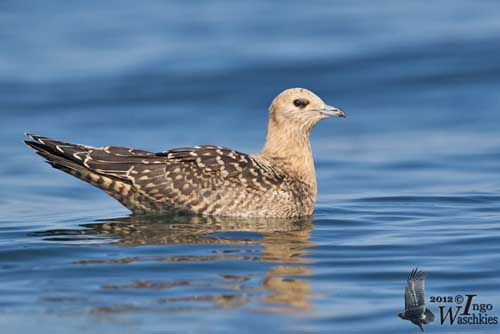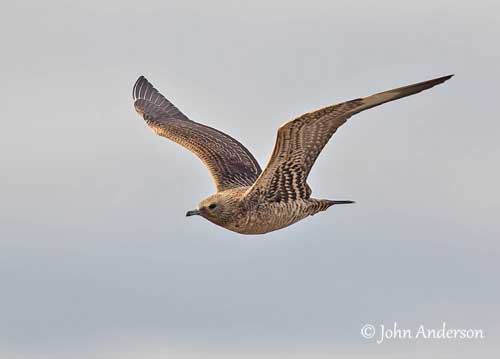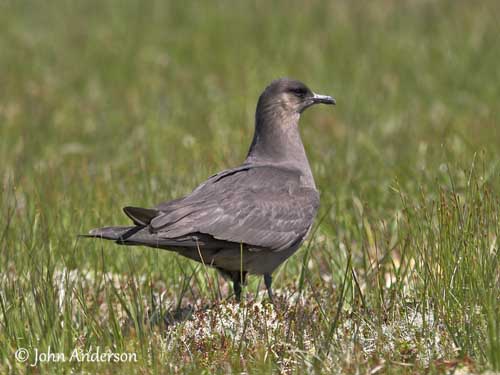
Fr: Labbe parasite
All: Schmarotzerraubmöwe
Esp: Págalo Parásito
Ital : Labbo
Nd: Kleine Jager
Sd: Kustlabb
Photographers:
John Anderson
John Anderson Photo Galleries
Steve Garvie
RAINBIRDER Photo galleries
Tom Merigan
Tom Merigan’s Photo Galleries
Ingo Waschkies
Bird Photography
Text by Nicole Bouglouan
Sources:
HANDBOOK OF THE BIRDS OF THE WORLD Vol 3 by Josep del Hoyo-Andrew Elliott-Jordi Sargatal - Lynx Edicions - ISBN : 8487334202
SKUAS AND JAEGERS by Klaus Malling Olsen and Hans Larsson - Pica Press Sussex,
ISBN: 1873403461
BirdLife International (BirdLife International)
Bird Web (Seattle Audubon Society)
Wikipedia, the free encyclopaedia
Parasitic Jaeger or Arctic Skua
Stercorarius parasiticus
Charadriiforme Order – Stercorariidae Family
BIOMETRICS:
Length: 41-46 cm
Wingspan: 110-125 cm
Weight: 330-610 gr
DESCRIPTION:
The Parasitic Jaeger occurs in both dark and pale morphs, with in addition, a number of intermediate plumages, especially tending towards the dark phase.
The name of this species comes from its feeding habits by kleptoparasitism from other seabirds.
Underwing-coverts, bill and legs are dark in all adults, like the pointed central rectrices forming tail projection. However, juveniles have shorter one.
There is a pale frontal blaze contrasting with the dark head. In all morphs, upperparts are dark greyish-brown with slightly darker flight feathers. The wings show a whitish crescent-shaped wing patch, formed by pale primary bases.
The dark morph shows uniform blackish-brown to greyish-brown plumage overall, with paler wash on neck sides. The head is often rather uniform.

The pale morph has similar upperparts, including wings and tail. The head is dark. The hindneck is washed yellowish. Underparts are whitish with dark breast band, more or less distinct but always paler than the head. Vent and undertail-coverts are dark like above.
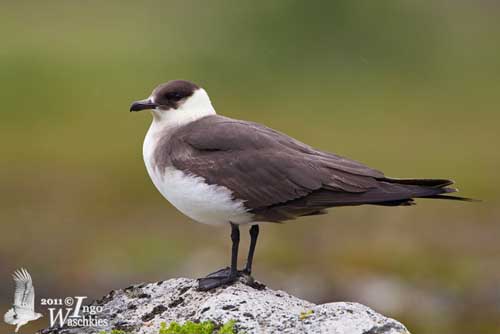
The intermediate dark morph resembles the dark one, except the paler neck sides contrasting with the dark head. Underparts are paler greyish-brown.
The pale intermediate is similar to pale morph except on the underparts with are pale greyish-brown and variably spotted or barred dark.
In all morphs, the bill is blackish with pale to whitish upperbase, less marked in dark phase. The eyes are brown. Legs and webbed feet are blackish.
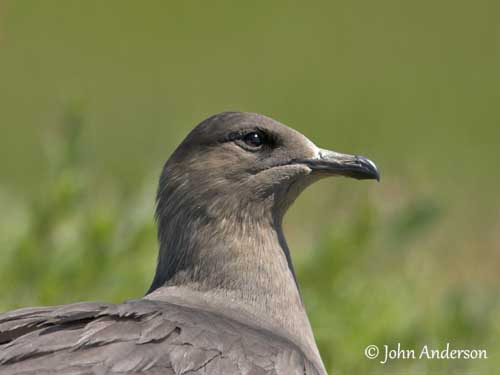
During winter, the pale morph has dark head less well defined. The underparts are more heavily dark-spotted. The breast band is spotted too. Mantle’s feathers are pale-edged. Uppertail and undertail-coverts are barred.
The dark morph is similar all year round, but dark hindneck and neck sides are uniform in winter.
Both adults are similar with female slightly larger than male.
The juvenile plumage is highly variable, from very pale head and underparts to almost uniform blackish-brown. They usually show orange to reddish-brown tinge on head and underparts. Upperparts show buffish scaling.
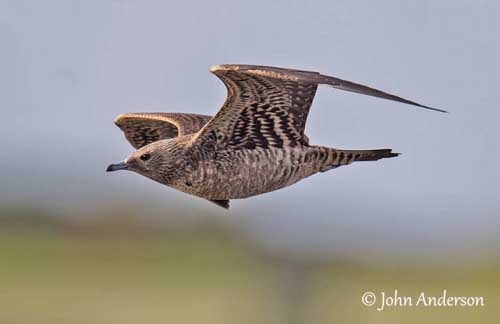
Some of them may have white bases to primaries, creating white flashes similar, but narrower, to those of the Great Skua.
The central rectrices are shorter and less pointed than in adults.
The bill is pale grey with black tip. Legs are pale too but feet are black.
The juvenile “pale type” has creamy to pale orange head with dark eyes. Underparts are pale with conspicuous barring on underwing-coverts and axillaries. On the upperparts, feathers show orange to buff edges.
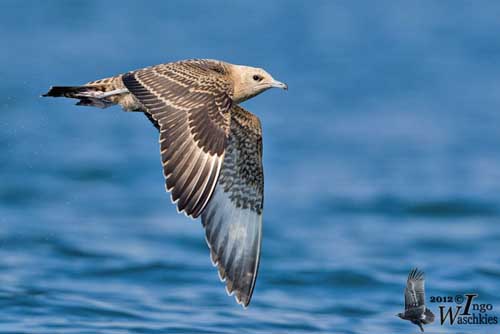
The juvenile “dark type” has brown to almost blackish-brown plumage. On upperparts and rump, feathers are edged pale brownish.
The juvenile “intermediate type” varies mostly towards the dark morph. The head is darker and contrasts with pale hindneck with developed head-streaking. The breast is darker and barred, and the belly can be sometimes barred too. Pale shafts to most primaries are conspicuous in flight.
VOICE: SOUNDS BY XENO-CANTO
The Parasitic Jaeger is usually silent away from the breeding grounds, but at breeding sites, it gives short “geeah” and “cat-like” calls.
Like other Stercorariidae species, it gives the typical “long-call” with lifted head and stretched neck, but it does not perform the “wing-raising-display” while calling.
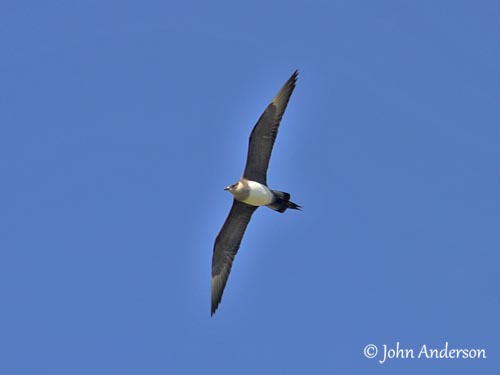
HABITAT:
The Parasitic Jaeger breeds on tundra, moorland or grassland. Outside the breeding season, this species is marine but mainly coastal. During winter, the birds often gather in estuaries or other coastal sites where numerous terns and small gulls are present.
RANGE:
The Parasitic Jaeger has circumpolar distribution in coastal tundra. It is highly migratory, breeding in N hemisphere in the Arctic region, often as far as Svalbard. Then, they migrate southwards to the S hemisphere.
BEHAVIOUR:
The Parasitic Jaeger feeds primarily by kleptoparasitism. This species steals food from other seabirds such as terns, puffins and others, if they have fish or other prey in the bill in order to feed their young.
The jaeger attacks the seabird in mid-air, harassing it and forcing it to drop or regurgitate its prey in flight.
Jaegers may sometimes attack their victims in small groups and chase down the poor seabird which regurgitates its food.
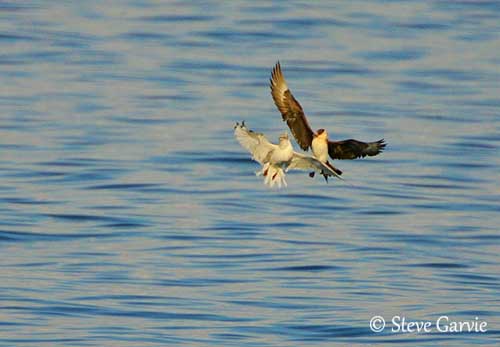
But when the Parasitic Jaeger is not associated with other seabirds, it feeds on wader chicks and bird’s eggs, occasionally on rodents in tundra habitat, adult and juvenile passerines, insects and berries, and sometimes offal and carrion.
During the breeding season, the Parasitic Jaeger defends large territories within which it can hunt for different types of preys. Even during migrations, feeding territories are defended by some birds too. During winter, it chases terns, gannets and shearwaters, and often feeds behind fishing vessels.
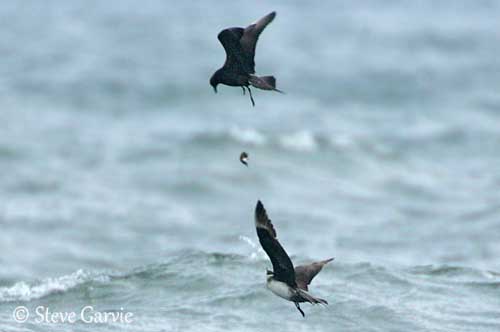
The Parasitic Jaeger occurs mainly along coasts or even inland during the nesting period. It may breed close to seabird’s colonies from which it obtains food by kleptoparasitism or taking their chicks and eggs.
The pair is territorial and uses the same nest-site in successive years. But they also may breed colonially where there are good food resources.
The yet established pair re-establishes the pair-bond when they meet on their usual nesting territory, with limited courtship ceremony.
They strongly defend the nesting area against intruders, and are notoriously aggressive towards all types of intruders. They deliver blows to the head of opponents with bill or feet.
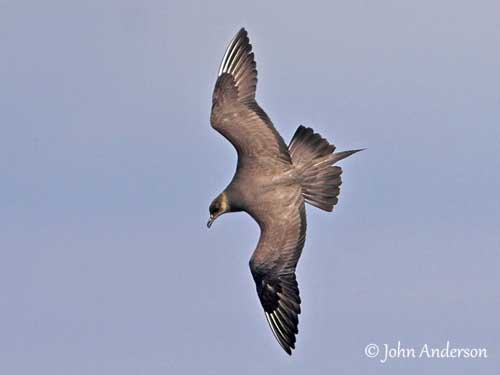
The Parasitic Jaeger is a trans-equatorial migrant, leaving its breeding grounds in N hemisphere in August, and moving slowly southwards down coasts, often in company of Laridae species. Some of them migrate over land. They winter in coastal areas in S hemisphere. They migrate northwards in April-May, but some immature birds may remain in S hemisphere.
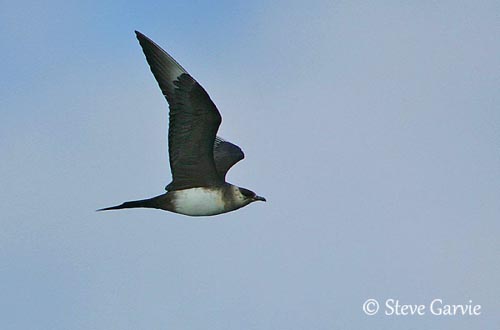
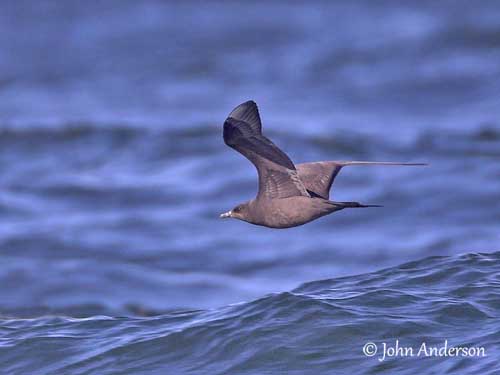
FLIGHT:
The Parasitic Jaeger performs easy, active flight with quick wingbeats interspersed with glides in arcs when skimming the wave’s tops.
During the attacks of seabirds for food, it starts the attack with low flight, then suddenly rising to the final assault, performing amazing turns and dives. It rarely attacks the bird itself, but it pursues it at great speed, forcing the seabird to regurgitate the food, immediately snapped from the air by the jaeger.
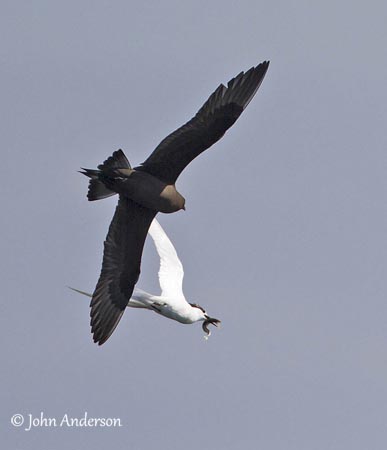
REPRODUCTION:
The breeding season starts through May or June.
The Parasitic Jaeger may breed colonially close to seabird sites, or widely scattered over the tundra.
The nest is an unlined scrape on the ground on arctic tundra, moorland, low country or sheltered grassy fields, usually close to streams or ponds where there are large tussocks and rocks used for watching the surroundings.
Some populations may nest on small islands and some birds may breed up to ten kilometres inland.
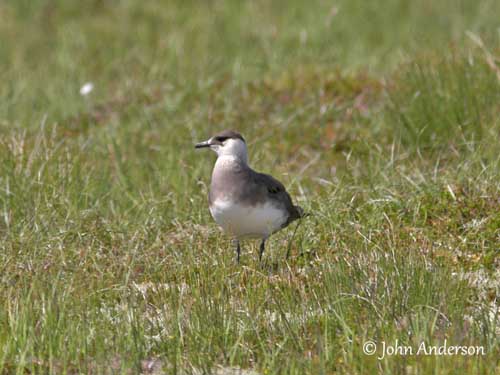
The female lays two olive-green eggs with dark markings. Incubation by both adults but mainly by the larger female lasts 26-27 days. At hatching, the chicks are covered in dark brown down. They are precocial and leave the nest 24/48 hours after hatching. They are fed on regurgitated food by both parents. The adults may perform the typical “broken wing display” if the chicks are threatened, in order to lead the predator away from the nest-site.
The young fledge at 26-30 days old. They are sexually mature at 3-4 years old.
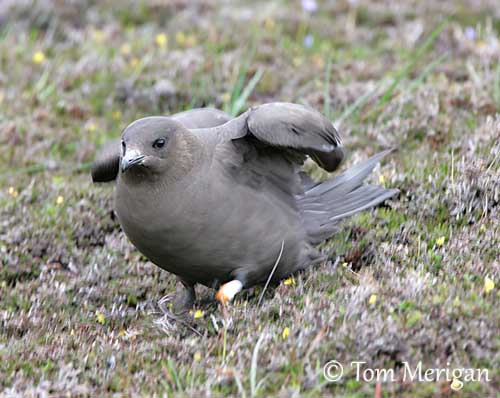
DIET:
The Parasitic Jaeger feeds primarily by kleptoparasitism, obtaining food from harassed seabirds which regurgitate their preys.
But the jaeger also hunts for wader chicks and bird’s eggs, some rodents, passerines and other small bird species, insects and berries, offal and carrion.
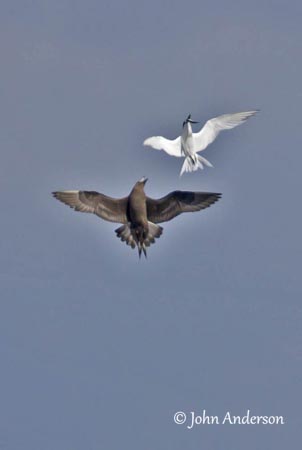
PROTECTION / THREATS / STATUS:
The Parasitic Jaeger has the most numerous populations of Stercorariidae family. They remain stable with no evidence of significant changes. Human persecutions remain very local, and the main predators, the Arctic Fox in high latitudes, and the Snowy Owl, may take eggs and chicks but do not affect the jaeger’s numbers.
This species is not currently threatened.
